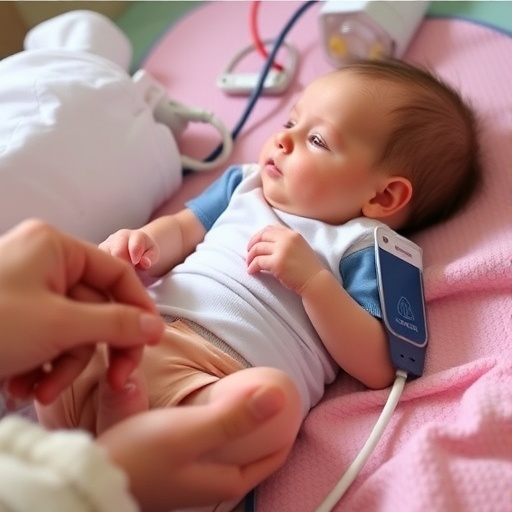In the delicate world of neonatal intensive care, precision in monitoring tiny, fragile lives is paramount. A recent breakthrough study has explored the viability of a commonly used method—noninvasive oscillometric blood pressure monitoring—in infants weighing under 500 grams during their critical first postnatal week. This pioneering research provides unprecedented insights into how medical professionals might rely on less intrusive means to keep close tabs on the cardiovascular health of these extremely low birth weight neonates, whose survival hinges on the minutest of clinical details.
Traditionally, invasive arterial blood pressure (IBP) monitoring has been the gold standard in neonatal care, offering continuous and accurate readings that help guide life-saving interventions. However, the insertion of arterial lines can be fraught with risks, including infection, vascular injury, and technical complications, particularly in the most vulnerable infant population. This context underscores the urgent need for safer yet reliable alternatives. Enter oscillometric noninvasive blood pressure (NIBP) monitoring, a method widely used in older patients but whose effectiveness in sub-500 gram infants had remained uncertain—until now.
This investigative endeavor, led by a team of neonatologists and researchers, sought to rigorously quantify the agreement between NIBP and IBP readings in this extremely low birth weight group. The team implemented a meticulous methodology to compare these two measurements over the crucial first seven days of life, a period marked by dramatic physiological transitions and heightened vulnerability. Their findings could hold the key to transforming blood pressure monitoring protocols, easing the clinical burden without sacrificing accuracy.
Understanding the importance of timing and measurements in neonatal care, the researchers focused on the initial postnatal week, when infants under 500 grams endure the highest risk of hemodynamic instability. Blood pressure fluctuations during this period are critical markers for a plethora of complications, including intraventricular hemorrhage, necrotizing enterocolitis, and organ perfusion deficits. By verifying whether noninvasive methods can reliably reflect invasive readings, the study addresses an urgent clinical question: can clinicians trust less intrusive devices to inform their decisions when every millimeter of mercury counts?
The technical challenge in this population arises from their extraordinarily small arm circumference and vulnerable vasculature, conditions that pose significant difficulties for cuff sizing and placement in oscillometric devices. Accuracy in oscillometric readings demands an optimal cuff-to-limb ratio, something notoriously difficult to achieve in these premature infants. The research team carefully selected appropriately sized cuffs and deployed protocols to ensure consistency, aiming to mitigate potential sources of error that might otherwise invalidate measurements.
Data analysis went beyond superficial comparisons, employing rigorous statistical methods to assess agreement and identify systematic biases. By pairing each oscillometric measurement with a near-simultaneous invasive measurement, the researchers generated an extensive dataset that captures real-time hemodynamic variability. Bland–Altman plots and correlation analyses illuminated the relationship between the two measurement modalities, exposing subtle trends and divergences critical for clinical interpretation.
Crucially, the results revealed a surprisingly high degree of concordance between oscillometric NIBP and invasive IBP for mean arterial pressure (MAP) values, the primary hemodynamic metric guiding neonatal management. While systolic and diastolic pressures exhibited somewhat less agreement, the mean arterial pressure, regarded as the most stable and clinically relevant parameter, showed promise as a candidate for safe noninvasive monitoring in this fragile population. This discovery suggests that, with careful implementation, NIBP could complement or even substitute IBP where arterial lines are contraindicated or infeasible.
The implications of these findings are profound. Reducing reliance on invasive monitoring could significantly decrease risks related to arterial catheterization, including infection rates and local vascular complications, enhancing neonatal outcomes. Furthermore, noninvasive monitoring simplifies nursing workflows and may improve comfort levels for infants, fostering a gentler care environment. These advantages align with the growing emphasis on minimally invasive neonatal practices aimed at mitigating iatrogenic harm in intensive care units worldwide.
Beyond direct clinical utility, the study charts a path toward technological innovation in neonatal monitoring devices. The challenges identified regarding cuff fit and signal fidelity in ultra-preterm infants call for specialized equipment design tailored to their unique physiology. This could spur manufacturers to develop next-generation NIBP monitors with enhanced sensitivity and miniaturized components, revolutionizing neonatal care and expanding monitoring capabilities beyond blood pressure to include other vital parameters.
Importantly, the study also highlights the necessity of continuous clinical vigilance and validation when adopting new monitoring technologies in vulnerable populations. Even with promising NIBP results, invasive monitoring remains indispensable in certain critical scenarios where absolute precision is non-negotiable. Clinicians must weigh the benefits and limitations of each method, integrating advanced algorithms and clinical judgment to optimize patient safety and outcomes.
This research represents a significant stride in the quest to improve outcomes for infants born at the frontier of viability. As neonatal intensive care units worldwide grapple with the ethical and clinical challenges of managing these tiny patients, evidence supporting safer, less intrusive monitoring techniques brings hope for better survival and quality of life. It reflects the collaborative spirit of modern medicine, where engineering, neonatology, and statistical science converge to push the boundaries of what is possible.
Furthermore, the timing of this study is pivotal, coinciding with technological advances in sensor miniaturization and automated data analysis, enabling the practical application of oscillometric monitoring innovations. It lays a groundwork for integrating artificial intelligence-driven analytics that may enhance signal interpretation and reduce artifacts, lending further credibility and utility to noninvasive approaches.
As with all pioneering clinical investigations, the authors advocate cautious optimism. They recommend larger, multi-center trials to validate these findings and assess long-term outcomes associated with different monitoring strategies. Additionally, they underscore the importance of training neonatal care teams in the nuances of both NIBP and IBP monitoring to maximize the reliability and safety of blood pressure measurements.
The study serves as a clarion call to the neonatal research community and industry stakeholders alike. Embracing noninvasive blood pressure monitoring tailored to micro-preemies is not merely a technological challenge but an ethical imperative—to reduce harm, enhance care, and ensure that the smallest patients have access to the most refined medical technologies available.
In conclusion, the feasibility of noninvasive oscillometric blood pressure monitoring in infants under 500 grams marks an exciting development in neonatal medicine. The compelling evidence of agreement with invasive methods opens a door to safer, more accessible monitoring modalities that could fundamentally alter the standard of care in neonatal intensive care units. As this field advances, the harmonious integration of clinical insight, technology, and compassionate care promises improved survival and health trajectories for these delicate little lives.
Subject of Research: Quantification of agreement between oscillometric non-invasive blood pressure and invasive arterial blood pressure in infants weighing under 500 grams during the first postnatal week.
Article Title: The feasibility of noninvasive blood pressure monitoring in infants with a birth weight under 500 grams.
Article References:
Kim, S.H., Jung, E., Han, H.M. et al. The feasibility of noninvasive blood pressure monitoring in infants with a birth weight under 500 grams. J Perinatol (2025). https://doi.org/10.1038/s41372-025-02415-w
Image Credits: AI Generated
DOI: https://doi.org/10.1038/s41372-025-02415-w
Tags: blood pressure measurement methodscardiovascular health in neonatesclinical monitoring in premature infantsextremely low birth weight infantsinfant care innovationsneonatal intensive careneonatal research advancementsnoninvasive blood pressure monitoringnoninvasive medical techniquesoscillometric blood pressure monitoringpatient safety in neonatologyrisks of invasive arterial monitoring





